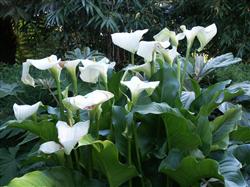Control of common diseases and insect pests of calla lotus

1. Disease 1. Calla lily soft rot: the soft rot detached from the plant near the surface, causing the leaves to wither upward, the succulent tubers to produce bony soft rot on millet, the roots also rotted, and the whole plant suddenly wilted and died. The edge of the leaf is damaged and becomes soft and wet-rotten. The pedicel is invaded, the flower turns brown, the pedicel soft rot falls off, the bacterial disease. Prevention and control methods: (1) when harvesting, remove the diseased corms, treat them with 40% formaldehyde 55 times solution for 1 hour and then store them. (2) the diseased plant was removed and burned in time, and the soil was disinfected with 40% formaldehyde 40 times solution around the diseased plant. (3) the planting depth of tubers should not exceed 5 cm to avoid excessive water supply. 2. Calla lotus leaf spot disease: there are three kinds of fungi causing calla lotus leaf spot disease, among which the occurrence of leaf spot is more common. At the initial stage, the disease spot on the leaf is small, nearly round, gray-white, gradually expanding and showing irregular large rotten spots, sometimes infecting flowers and pedicels. Prevention and treatment methods: (1) remove the residue of diseased leaves in time to avoid excessive water supply. Do not water the plant directly. (2) spray 25% enemy emulsifiable concentrate 1000 murine 1500 times, or 80% Dasheng 500 times, once every 15 days for 3 times in a row. 3. Calla lotus virus disease: calla lotus virus shows two symptoms: mosaic symptom is typical mosaic of diseased plant leaves, leaf shrinkage and distortion, white spot or ring spot, chlorotic ring spot or stripe near leaf vein, twisted leaf, white spot on small pedicel, light spot flower deformity on flower bud, mosaic disease can be transmitted by juice and peach aphid. Prevention and control methods: (1) select disease-free mother plant culture, diseased plants found in the growing period in time to pull out and burn. (2) during the whole growing period, 50% marathon 1000 times or 2.5% deltamethrin EC 3000 times were used to control aphids and thrips. Second, insect pests two-point spider mites: alias cotton red spider, hosts are sunflower, calla lily, rose, peach, asparagus, wax plum, peacock grass, hibiscus, rose and so on. Two-spot spider mites absorb leaf juice on the back of the leaves, light leaves turn red, such as fire, heavy leaves fall. Prevention and control methods: (1) removal of diseased leaves and centralized treatment. (2) spray 1000 times of dicofol, or 2000 times of 20% dicofol, or 1500 times of Icas.
- Prev

Mosaic disease of calla lilies
The common diseases of calla lilies are: ① soft rot. During the growing period, the soft rot detached from the plant near the surface, and caused the leaf edge to soften, wet rot to wither, flower color to brown, pedicel soft rot to fall off, and downward to cause sticky soft rot of tuber, root rot, and even wilting and death of the plant. Prevention and control measures: a.
- Next

Calla lily and Jinmai single flower
Plant materials and utensils calla lily, golden vein single flower, iron cross begonia, four seasons begonia, flower leaf vine Changchun, wooden utensils and so on. The composition of the work is balanced, the lines are smooth and dynamic. Yellow and green are the main colors, plants echo each other, while red flowers and brown ones.
Related
- Fuxing push coffee new agricultural production and marketing class: lack of small-scale processing plants
- Jujube rice field leisure farm deep ploughing Yilan for five years to create a space for organic food and play
- Nongyu Farm-A trial of organic papaya for brave women with advanced technology
- Four points for attention in the prevention and control of diseases and insect pests of edible fungi
- How to add nutrient solution to Edible Fungi
- Is there any good way to control edible fungus mites?
- Open Inoculation Technology of Edible Fungi
- Is there any clever way to use fertilizer for edible fungus in winter?
- What agents are used to kill the pathogens of edible fungi in the mushroom shed?
- Rapid drying of Edible Fungi

